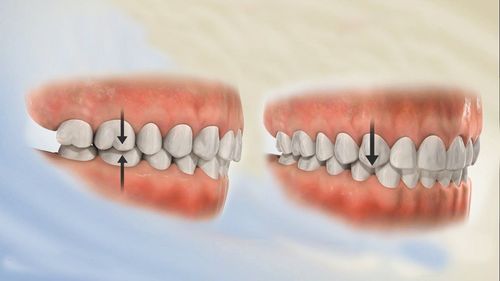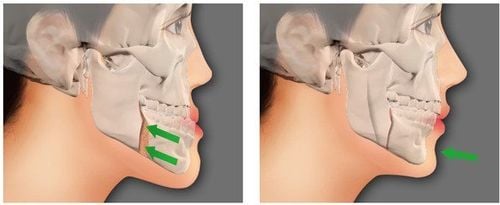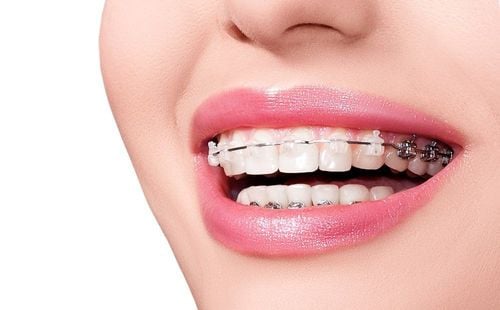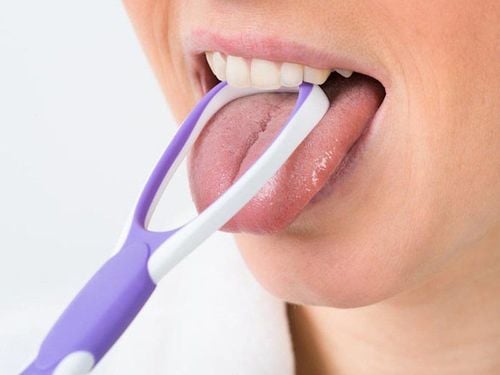This is an automatically translated article.
Underbite is one of the defects of the jawbone that makes you lose your facial aesthetics and always feel very self-deprecating. With the development of modern medicine, now the method of mandibular surgery has completely overcome this situation. So is jaw surgery painful or dangerous? The following article will help you better understand jaw surgery.
1. What is mandibular surgery?
Not everyone is born with an ideal jawline. There are many people who are self-deprecating about the disproportionate two teeth, the upper jaw is indented compared to the lower jaw, or in folklore it is often called underbite. But at the present time, that condition can be completely corrected by orthopedic surgery of the jaw.
The condition of the jaw bone can be due to genetic factors, that is, if a member of your family has been underbite, it is likely that you will also have it. But in some cases, it is caused by a disease, but this amount is very rare, specifically:
The body produces too much growth hormone, causing the tissues to become excessively large, including your lower jaw. Gorlin syndrome (basal cell nevus syndrome) is a fairly rare genetic condition that causes abnormal facial features, including an enlarged jaw in some cases. A very rare congenital condition called Acro Dysostosis affects bone growth. People with this syndrome often have short arms and legs, a low nose, a small upper jaw that makes the lower jaw appear larger than normal. Orthodontic surgery of the jaw is performed by maxillofacial surgeons to correct a wide range of skeletal abnormalities, small and large teeth, including misalignment of the jaws and teeth, and thus can improve Improve chewing, speaking and breathing. Although a patient's appearance can be significantly improved as a result of surgery, the goal of orthopedic surgery is to correct functional problems.
2. Is jaw surgery complicated?
Orthopedic surgery involves correcting substandard jaws (orthognathic surgery) or misaligned teeth. In most cases, straight, aligned, orthodontic teeth can be performed before orthodontic surgery to reposition misaligned jaws. This not only improves the appearance of the face, but also ensures that the teeth respond correctly and function properly. Orthopedic surgery allows repositioning of teeth and facial bones to create a functional, well-proportioned jaw. State-of-the-art technology, including X-rays and computers, allows patients to view projections prior to surgery.
Patients will be carried out necessary procedures, undergo pre-operative steps in accordance with the standards of the Ministry of Health, perform post-surgery at the hospital, re-examined after a certain period of time specified by the doctor.
Mandibular surgery depends on the situation of each patient, so it will be difficult to confirm whether it is complicated or simple. But the ultimate goal is to move your teeth and jaw to a more balanced, functional, and healthy position. Although the goal of orthognathic surgery is to improve your bite and function, some patients also experience improvements in their appearance and voice. The results of orthodontic surgery can have a positive and significant impact on many aspects of your life.
3. Mandibular surgery procedure
Examination and consultation before jawbone surgery You will need to go to reputable hospitals with expertise in the field of maxillofacial surgery to determine the cause of the underbite, thereby having the appropriate treatment. .
Before surgery, you will likely receive orthodontic treatment in the form of braces. This therapy can take several months to complete and is an important part of your treatment plan. Your orthodontist will straighten and position your teeth in preparation for surgery. Positioning your teeth in preparation for surgery can take some time, but it is an imperative step to help make your surgery a success.
Physical exam Your doctor will give you general blood and urine tests to determine if you have any medical problems. After the results are available, your doctor will inform you if you are eligible for surgery.
Local anesthesia Is jaw surgery painful? Anesthesia will be performed by specialists to help you not feel pain and keep you as calm as possible while the surgery is taking place.
Performing surgery Once you are asleep, the anesthesiologist will place a small tube inside your nose to deliver oxygen during surgery. An opening is made inside the upper jaw just behind and next to the last teeth of the lower jaw. This opening will be about 3 inches long and the resulting scar will be completely inside the mouth.
The posterior part of the jaw, located behind and below the last erupting teeth, will be accessed through this opening. This is the part of the jawbone that will be separated. A cut is made along the top and side edges of the jaw. The purpose of these cuts is to separate the jawbone in a way that creates extensive overlap of bone between the surfaces being cut.
Through the edges of the bone that have been cut, bone-separating tools called “osteotomes” are used to separate the jaw. When the bones on both sides have separated, the lower jaw bone can be moved to a new position. If the lower jaw is displaced posteriorly, a small band of bone may need to be removed. The lower jaw is securely fixed to the new position with screws or a combination of plates and screws. In certain cases, teeth may be joined together to help keep the lower jaw in place. The holes in the mouth will then be closed with stitches that will slowly dissolve.
Postoperatively After surgery, your surgeon will provide instructions on a modified diet, which may include solids and liquids, as well as a transition schedule. eat normally. You may also be asked to limit your use of tobacco products and avoid strenuous physical activity.
In general, jawbone surgery does not cause too much pain, but you still need to take pain medication prescribed by your doctor. For the first few days, you will feel some discomfort and it may take up to a few weeks for the pain to go away completely. You'll need antibiotics given through a vein in your arm while you're in the hospital, to make sure the surgical area heals without infection. After you're discharged from the hospital, your doctor will prescribe pain medication and a course of antibiotics.
Pain after orthodontic surgery can be easily controlled with medication and patients can usually return to work or school 1-3 weeks after surgery, depending on how they are feeling. While the initial healing period is about 6 weeks, full healing of the jaws will take 9 to 12 months.
4. Complications can occur after orthopedic jaw surgery
Mandibular surgery is very rare, but you need to pay attention and go to the hospital immediately if you have the following conditions:
Excessive bleeding: Excessive bleeding after surgery is abnormal. often. When this happens, you should stop the bleeding by applying a clean towel or cotton ball to the area for at least 10 minutes. If you can't stop bleeding, you need to go to the hospital right away. Infection: The jaw will be fixed with small plates and screws so it can be permanently held in place. Where the discs and screws used are titanium, you won't be affected by metal detectors in the airport... But sometimes they can become infected and need to be removed. This problem is normal and will occur within a few months after surgery.
5. Problems you may face after jawbone surgery
Swelling and numbness: Swelling will reach its peak after 2-3 days and can be very serious. It may be difficult to speak or drink normally. Most swelling will clear up in about 2 weeks. The lower lip may be numb on one or both sides of the face. This is usually temporary; however, it may take several weeks or months for the numbness in the lower lip to go away. But in some patients the condition can last forever. Discomfort: Most discomfort you will experience after surgery will be facial swelling rather than pain from the surgery itself. You will receive medicine to relieve your discomfort. Applying a cool compress to your face and lying on your back while sleeping with your face elevated above your heart will also help reduce swelling. Use a moisturizer to avoid drying out your lips. Recovery: It's especially important to listen to your surgeon and orthodontist's instructions about the foods you can eat after surgery and when it's safe to eat them. Eating the right food will help the wound heal. Once the swelling goes away, you will be able to move your jaw to a greater extent. Your orthodontic care will continue after surgery. This can be a form of elastic band therapy to help guide the lower jaw into the upper jaw. Braces may also be continued for several months after surgery. Talk to your orthodontist to find a treatment plan.
6. Is it possible to correct the underbite without surgery?
Jaw deviation or underbite can occur due to many different causes, from genetic factors to bad habits such as leaning on the chin, chewing on one side, sleeping on one side,... face severely reduced aesthetics, underbite interferes with chewing activities. To treat the misaligned jaw will have to intervene with dental measures, then many people question whether or not it is possible to correct the underbite without surgery?
Currently, there are 3 types of jaw misalignment including jaw deviation due to teeth, jawbone or jaw deviation due to both teeth and jawbone. For each different case, the doctor will specify the appropriate method, it is possible to correct the deviated jaw non-surgically with braces.
Braces are applied to cases of crooked, overbite, underbite, and misaligned jaws caused by teeth, thereby helping to adjust and align the teeth, bringing the bite of the two jaws into balance. However, the time of braces is quite long, usually ranging from 18-24 months, in more severe cases, up to 36 months.
However, braces cannot interfere with the jawbone structure, so you should not expect too much braces results for cases of jaw deviation due to jaw bone. At that time, it will have to perform jaw surgery, directly interfering with the jawbone to adjust the two jaws to match each other. Thus, braces are a non-surgical jaw alignment technique that doctors can prescribe to correct teeth and bite. To know if braces in your case are effective or not, you should visit a reputable dentist directly to have a doctor examine and give appropriate treatment.
Please dial HOTLINE for more information or register for an appointment HERE. Download MyVinmec app to make appointments faster and to manage your bookings easily.













